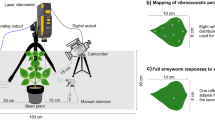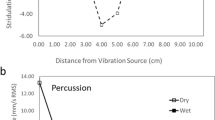Abstract
Pupae of several insect species are known to generate air-borne sounds and/or substrate-borne vibrations, but the functions of the sounds/vibrations are not well understood. Here, we present the first evidence of vibratory communication between pupae and larvae of a group-living Japanese rhinoceros beetle Trypoxylus dichotoma which inhabits humus soil. The last-instar larvae of this beetle construct their own pupal cells to ensure normal pupation and eclosion. These cells are fragile and subject to damage from burrowing larvae because pupae and larvae co-inhabit the same patches of humus. In laboratory experiments, we demonstrated that pupal cells harboring live pupae were less likely to be broken by larvae than those harboring dead pupae. It was also demonstrated that pupae produced vibrations in response to larvae approaching the pupal cells. High-speed video and vibration analyses showed that pupae emitted 3–7 pulses at 1.3-s intervals by beating their pronotum against the inner wall of the pupal cell. The pupal vibration was of low frequency with a maximum energy at ≈ 100 Hz. The drumming behavior was more frequently observed in the presence of an approaching larva than in its absence. When pupal vibrations were played back near to vacant artificial pupal cells, these cells were rarely disturbed by the larvae. These results provide evidence that pupae generate vibrations to deter conspecific larvae, thereby preventing damage to the cells. This larval response to pupal vibrations may have evolved through preexisting anti-predator and/or sib-killing-avoidance behavior.





Similar content being viewed by others
References
Barbero F, Thomas JA, Bonelli S, Belletto E, Schönrogge K (2009) Queen ants make distinctive sounds that are mimicked by a butterfly social parasite. Science 323:782–785
Cocroft RB (1999) Parent-offspring communication in response to predators in a subsocial treehopper (Hemiptera: Membracidae: Umbonia crassicornis). Ethology 105:553–568
Cocroft RB (2005) Vibrational communication facilitates cooperative foraging in a phloem-feeding insect. Proc R Soc B 272:1023–1029
Cocroft RB, Hamel JA (2010) Vibrational communication in the “other” social insects: a diversity of ecology, signals, and signal function. In: O’Connell-Rodwell C (ed) The use of vibrations in communication: properties, mechanisms and function across taxa. Research Signposts, India, pp 47–68
Cocroft RB, Rodríguez RL (2005) The behavioral ecology of insect vibrational communication. BioScience 55:323–334
Čokl A, Virant-Doberlet M (2003) Communication with substrate-borne signals in small plant-dwelling insects. Annu Rev Entomol 48:29–50
Edwards DP, Yu DW (2007) The roles of sensory traps in the origin, maintenance, and breakdown of mutualism. Behav Ecol Sociobiol 61:1321–1327
Eisner T, Eisner M (1992) Operation and defensive role of “gin traps” in a coccinellid pupa (Cycloneda sanguinea). Psyche 99:265–273
Field LH, Matheson T (1998) Chordotonal organs in insects. Adv Insect Physiol 27:1–228
Fletcher LE (2007) Vibrational signals in a gregarious sawfly larva (Perga affinis): group coordination or competitive signaling? Behav Ecol Sociobiol 61:1809–1821
Gardner A, Griffin AS, West SA (2010) Altruism and cooperation. In: Westneat DF, Fox CW (eds) Evolutionary behavioural ecology. Oxford Univ Press, New York, pp 308–326
Hamilton WD (1964a) The genetical evolution of social behaviour I. J Theor Biol 7:1–16
Hamilton WD (1964b) The genetical evolution of social behaviour II. J Theor Biol 7:17–52
Hill PSM (2009) How do animals use substrate-borne vibrations as an information source? Naturwissenschaften 96:1355–1371
Hinton HE (1946) The “gin-traps” of some beetle pupae; a protective device which appears to be unknown. Trans R Entomol Soc Lond 97:473–496
Hinton HE (1948) Sound production in Lepidopterous pupae. Entomologist 81:254–269
Ichikawa T, Kurauchi T (2009) Larval cannibalism and pupal defence against cannibalism in two species of tenebrionid beetles. Zool Sci 26:525–529
Laird NM, Ware JH (1982) Random-effects models for longitudinal data. Biometrics 38:963–974
Lambert D (1992) Zero-inflated Poisson regression with an application to defects in manufacturing. Technometrics 31:1–14
Mankin RW, Brandhorst-Hubbard J, Flanders KL, Zhang M, Crocker RL, Lapointe SL, McCoy CW, Fisher JR, Weaver DK (2000) Eavesdropping on insects hidden in soil and interior structures of plants. J Econ Entomol 93:1173–1182
McIver SB (1985) Mechanoreception. In: Kerkut GA, Gilbert LI (eds) Comprehensive insect physiology, biochemistry and pharmacology VI. Pergamon, New York, pp 71–132
R Development Core Team (2010) R: a language and environment for statistical computing. R Foundation for Statistical Computing, Vienna, Austria
Rodríguez RL, Ramaswamy K, Cocroft RB (2006) Evidence that female preferences have shaped male signal evolution in a clade of specialized plant-feeding insects. Proc R Soc B 273:2585–2593
Stumpner A, von Helversen D (2001) Evolution and function of auditory systems in insects. Naturwissenschaften 88:159–170
Sullivan-Beckers L, Cocroft RB (2009) The importance of female choice, male-male competition, and signal transmission as causes of selection on male mating signals. Evolution 64:3158–3171
Travassos MA, Pierce NE (2000) Acoustics, context and function of vibrational signalling in a lycaenid butterfly-ant mutualism. Anim Behav 60:13–26
Tsurumaki H (1987) Collecting and breeding of the Japanese rhinoceros beetle. Saishu To Shiiku 49:254–257 (in Japanese)
Virant-Doberlet M, Čokl A (2004) Vibrational communication in insects. Neotrop Entomol 33:121–134
Yack JE, Smith ML, Weatherhead PJ (2001) Caterpillar talk: acoustically mediated territoriality in larval Lepidoptera. Proc Natl Acad Sci USA 98:11371–11375
Acknowledgements
We thank A. Surlykke, H. Nishino, R. Nakano, and the two anonymous referees for invaluable comments on the manuscript, W. Ohmura and M. Jinkawa for the loan of the highspeed video and the vibration excitor, and R. Nakano for preliminary vibration recordings. This work was supported by Grants-in-Aid from the Ministry of Education, Culture, Sports, Science, and Technology of Japan (T.T., Y.I.).
Author information
Authors and Affiliations
Corresponding author
Additional information
Communicated by J. Choe
Rights and permissions
About this article
Cite this article
Kojima, W., Takanashi, T. & Ishikawa, Y. Vibratory communication in the soil: pupal signals deter larval intrusion in a group-living beetle Trypoxylus dichotoma . Behav Ecol Sociobiol 66, 171–179 (2012). https://doi.org/10.1007/s00265-011-1264-5
Received:
Revised:
Accepted:
Published:
Issue Date:
DOI: https://doi.org/10.1007/s00265-011-1264-5




